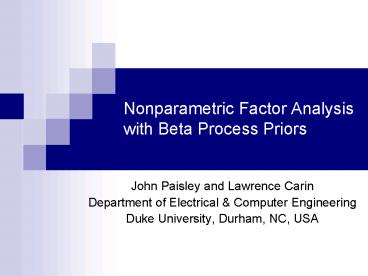Nonparametric Factor Analysis with Beta Process Priors PowerPoint PPT Presentation
1 / 16
Title: Nonparametric Factor Analysis with Beta Process Priors
1
Nonparametric Factor Analysis with Beta Process
Priors
- John Paisley and Lawrence Carin
- Department of Electrical Computer Engineering
- Duke University, Durham, NC, USA
2
Outline
- Introduction
- Beta Process Review
- Beta Process Factor Analysis Model (BP-FA)
- Variational Inference for the BP-FA Model
- Experiments
- Conclusion
3
Introduction
- Nonparametric Bayesian priors are useful for
finding compact statistical representations of a
data set without limiting the potential
complexity of the model (e.g., the Dirichlet
process) - Factor analysis modeling is a framework where
nonparametric priors can be useful. FA models are
used to separate the important covariance
structure of a data set from idiosyncratic noise.
Inferring the value for K is something that
suggests the use of a nonparametric prior. - The beta process (two-parameter) is a
nonparametric prior that allows - (above), while selecting a
sparse subset of columns of . This process is
denoted
4
The Beta Process
- Illustration Define H0 to correspond to the
uniform distribution Uni(0,1)
5
The Beta Process
- Illustration Define H0 to correspond to the
uniform distribution Uni(0,1)
6
The Beta Process
- Illustration Define H0 to correspond to the
uniform distribution Uni(0,1)
7
Beta Process Properties
- By integrating out each to obtain the
Indian buffet process (Griffiths Ghahramani,
2005), additional properties of the beta process
can be derived. - Let zi be the binary vectors on the previous
slide. In the limit as - For any set of N vectors, z1,,zN, if CN is the
total number of unique locations where there is a
one, then
8
Beta Process Factor Analysis (BP-FA)
- For the factor analysis model, we model the
generation of X using a finite approximation to
the beta process. This approximation allows for
variational inference to be performed. - Below is a noiseless, unweighted example of a
draw from the model, where we show the sparseness
of the BP prior using the vector of probabilities
generated in the previous slides. (Only 23 of the
1000 factors are used in N 100 samples)
An illustration of the structure of the beta
process prior (noiseless, unweighted model)
9
Beta Process Factor Analysis (BP-FA)
- The generative process is at right.
- This approximation can be thought of as similar
to using a finite Dirichlet prior for mixture
modeling. The benefit of sparseness is still
present (since K is set to a large number). - The mean and covariance under this truncation is
given at right. We see that the model remains
well-defined as
10
Variational Inference for the BP-FA Model
11
Variational Inference for the BP-FA Model
12
Experiments Toy Data
- We ran three experiments On toy data, on the
MNIST digits dataset and on the HGDP-CEPH cell
line panel
- We generated N 250 samples in D 25
dimensions. We sampled H with a,b 1, W 1 and
we set - K 100 for inference.
- The essential structure was uncovered.
- An issue was the splitting of factors (some
columns in the loading matrix were similar)
13
Experiments MNIST Digits
- We also trained on N 2500 odd digits. We set
a,b 1 and K 100. - At right, we see that a sparse subset of the
factors were selected to represent the data. - We also mention that inference was fast, owing to
the deterministic nature of the variational
method (far fewer iterations are required than
for MCMC sampling).
14
Experiments HGDP-CEPH Cell Line Panel
- A D 377 dimensional genotype data set sampled
from populations across the world. - Below, we show the reconstruction of the data
set. - The noise in the data was significantly reduced,
while the essential structure was preserved.
15
Conclusion and Future Work
- We have presented a nonparametric model for
performing factor analysis that uses the beta
process prior. - A finite approximation to the beta process
allowed for variational inference to be
performed. - We are currently in the process of expanding
these ideas in a full-length paper, where we will
look more in depth at applications. - A stick-breaking construction of the beta process
has been recently derived by the authors. Future
work is needed to rigorously prove convergence
properties (help is welcome!)
16
References

